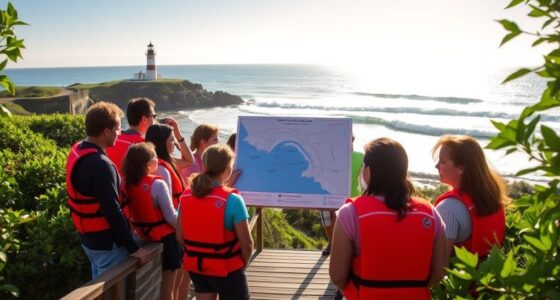To prepare for a mega-quake, understand the risks and monitor fault line activity with advanced seismic tools. Create a thorough emergency plan, including evacuation routes and communication methods. Assemble essential supplies like water, non-perishable food, and first aid kits. Reinforce your home to withstand shaking and secure heavy furniture. Join community drills, build support networks, and stay informed on early warning systems. Keep these strategies in mind—learning more can help you stay safe when disaster strikes.
Key Takeaways
- Monitor fault line activity and utilize early warning systems for seconds of advance notice.
- Develop and regularly practice a comprehensive family emergency plan with clear evacuation routes.
- Assemble and maintain an emergency kit with essential supplies like water, food, first aid, and tools.
- Secure your home by anchoring furniture, reinforcing structures, and removing hazards to reduce injury risks.
- Participate in community drills and establish neighborhood communication networks to enhance collective preparedness.
Understanding the Risks of Mega-Quakes

Understanding the risks of mega-quakes is essential because these powerful events can cause widespread destruction and loss of life. You need to recognize how tectonic plate movements drive these massive earthquakes, as they create stress along fault lines. When these plates grind or slip suddenly, they produce intense seismic activity patterns that can release enormous energy. By studying these patterns, scientists identify regions at higher risk for mega-quakes. Your awareness of how tectonic activity influences earthquake potential helps you better prepare and understand the likelihood of such events. While we can’t prevent these natural phenomena, understanding their origins and triggers allows you to make smarter safety decisions and stay alert for signs of increased seismic activity. Additionally, monitoring fault line activity can provide early warnings and improve preparedness efforts. Recognizing the signs of seismic stress accumulation can also help communities implement proactive safety measures. Furthermore, advances in seismic monitoring technology enhance our ability to detect subtle shifts that precede large earthquakes, improving early response strategies. Staying informed about tectonic plate dynamics can further aid in assessing regional earthquake risks and preparedness. Understanding how stress builds along fault lines helps in predicting the likelihood of future mega-quakes and can inform long-term safety planning.
Recognizing Early Warning Signs and Monitoring Systems
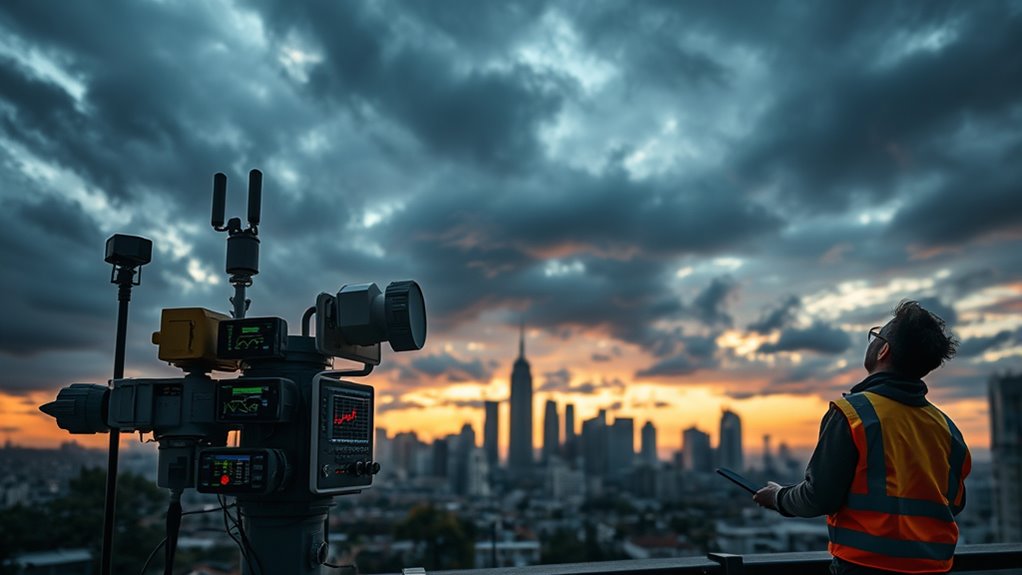
Recognizing early warning signs and utilizing monitoring systems can substantially improve your preparedness for potential mega-quakes. Seismic early warning systems detect initial, less destructive seismic waves that travel faster than the main quake, giving you precious seconds to take cover. Monitoring technology, such as real-time data from seismometers, continuously tracks ground movements and alerts authorities and individuals when unusual activity suggests an impending quake. Staying informed through these systems allows you to respond quickly and avoid danger. It’s important to understand that early warning signals may include small tremors or unusual ground vibrations. By paying attention to alerts from seismic monitoring networks and understanding the signs, you can act swiftly to protect yourself and your loved ones before the full impact arrives. Additionally, understanding the different air quality indicators can help you determine if your environment has been compromised after a quake.
Creating a Comprehensive Emergency Plan

Having a thorough emergency plan is essential for effectively responding to a mega-quake. Start by outlining clear evacuation procedures so you and your family know exactly where to go and how to get there safely. Practice these routes regularly to ensure everyone is prepared in a panic. Develop communication strategies, such as designated check-in points and emergency contacts, to stay connected when phone lines might be overwhelmed. Make sure each person understands the plan and knows their role. Include details like how to reach neighbors or nearby shelters. Keeping everyone informed and prepared minimizes chaos and helps you respond quickly. A well-crafted plan ensures you’re ready to face a mega-quake with confidence and resilience. Incorporating effective communication methods and emotional support strategies into your plan can also help manage stress and maintain mental well-being during emergencies. Additionally, understanding financial aspects of emergency planning, such as having accessible funds or insurance information, can be critical if disaster strikes. Preparing a comprehensive emergency kit with supplies tailored to your family’s needs is also vital for safety and comfort during the initial aftermath. To further enhance preparedness, consider integrating psychological resilience techniques to help cope with the stress and uncertainty that follow such a disaster.
Assembling an Essential Disaster Supply Kit
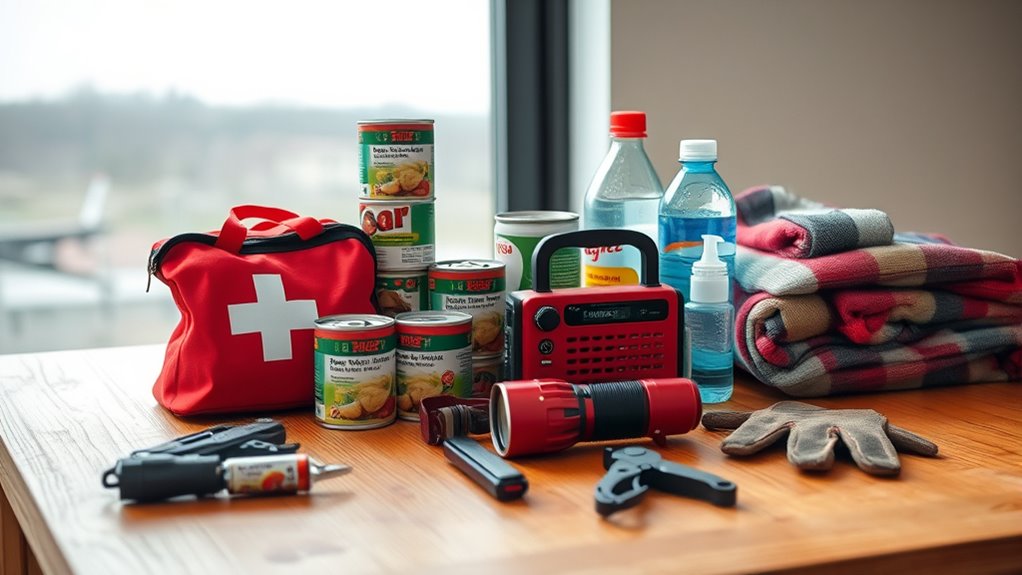
To stay prepared for a mega-quake, you need to assemble an essential disaster supply kit that can sustain your family for at least three days. Start with first aid essentials like bandages, antiseptics, pain relievers, and any necessary medications. Include sturdy bottled water—at least one gallon per person per day—and non-perishable food items, such as canned goods, energy bars, and dried fruits. Follow food storage tips by rotating supplies regularly and storing them in a cool, dry place. Pack flashlights, batteries, a multi-tool, and a whistle for emergencies. Don’t forget hygiene items like wipes and sanitary supplies. Keep everything in a durable, easily accessible container. Preparing this kit guarantees you’re ready to handle immediate needs after a major quake strikes. Proper disaster preparedness is essential to ensure your safety and resilience in the face of unexpected disasters. Additionally, understanding the role of contrast ratio in projectors can help you optimize your home setup for better visibility during power outages or emergencies. Being aware of potential security vulnerabilities in new emergency equipment can also help you mitigate risks during crises. Conducting a comprehensive risk assessment can further enhance your readiness by identifying specific hazards in your area.
Securing Your Home and Property
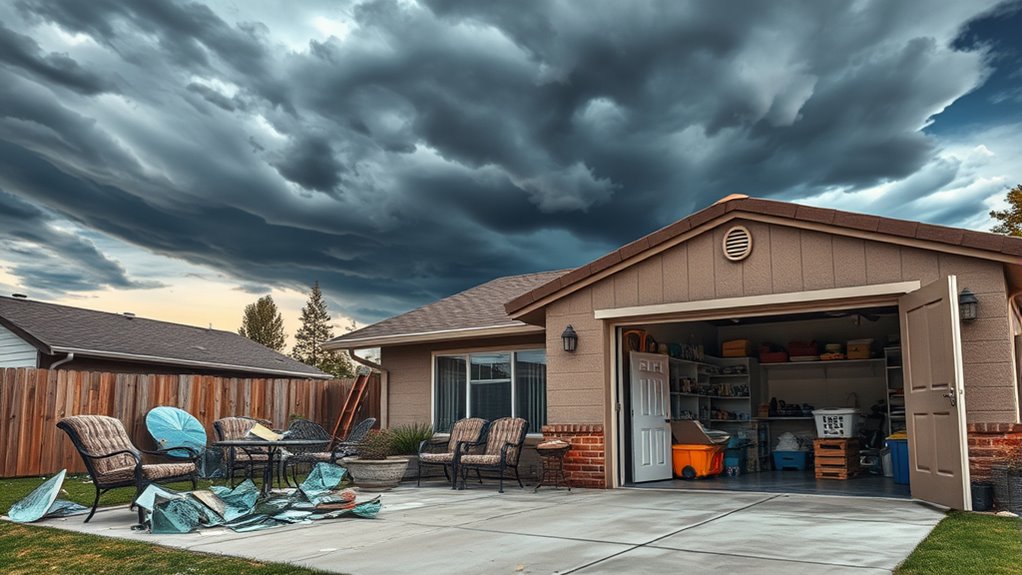
Securing your home and property is a crucial step in earthquake preparedness, as it helps prevent damage and keeps you safer during a quake. Strong home security measures protect against falling objects and structural failures. Property protection involves securing furniture, securing windows, and reinforcing walls to minimize hazards. Use straps and brackets to anchor heavy items and prevent them from toppling. Install window latches to avoid glass shattering. Regularly inspect and maintain your property to identify vulnerabilities. Consider adding seismic reinforcements if needed. Here’s a quick guide:
| Action | Purpose |
|---|---|
| Anchor heavy furniture | Prevent toppling during shaking |
| Secure windows | Avoid glass shattering |
| Reinforce door frames | Enhance structural integrity |
| Install safety latches | Secure cabinets and drawers |
| Trim trees near home | Reduce risk of falling branches |
A comprehensive understanding of home safety measures can significantly improve your resilience during an earthquake. Additionally, understanding building reinforcements can help you make more informed decisions about strengthening your property. Incorporating seismic reinforcements can further enhance your home’s resilience to extremely large quakes.
Developing Community Preparedness Initiatives

You can bolster your community’s resilience by participating in training programs that prepare everyone for earthquakes. Developing clear emergency plans guarantees that everyone knows their roles and how to respond quickly. Together, these initiatives make it easier to protect lives and property when a mega-quake strikes. Regularly reviewing local retail hours can also ensure essential supplies are accessible during emergencies. Incorporating community engagement strategies can further strengthen collective preparedness and response efforts. Engaging residents in disaster readiness education can significantly improve overall community resilience, especially by emphasizing the importance of understanding vetted mother baby kids safety measures for vulnerable populations. Additionally, fostering a sense of community cohesion helps ensure coordinated efforts during crises.
Community Training Programs
Community training programs are essential for building resilience and ensuring residents know how to respond effectively during a mega-quake. By participating in programs that include community CPR, you learn vital life-saving skills that could make a difference in emergencies. Neighborhood drills are also crucial, allowing you to practice swift evacuation, secure hazards, and communicate with neighbors. These drills help identify weaknesses in your community’s response plan and build confidence in handling chaos. When everyone is trained and prepared, the entire neighborhood becomes more resilient, reducing injury and chaos during a disaster. You’ll feel empowered knowing you can assist others and follow established safety protocols. Regular training ensures your community is ready to act swiftly and effectively when a mega-quake strikes.
Local Emergency Planning
Building a thorough emergency plan is essential to make certain that everyone knows their role when a mega-quake hits. Developing community preparedness initiatives strengthens your neighborhood’s resilience. Start by:
- Mapping clear evacuation routes and sharing them with all residents, so no one gets lost or trapped.
- Establishing a neighborhood watch to coordinate communication, monitor hazards, and assist vulnerable neighbors.
- Organizing regular drills to practice evacuation and emergency procedures, ensuring everyone stays prepared and confident.
- Incorporating disaster preparedness strategies into your community programs to better anticipate and mitigate potential risks.
These steps foster unity and reduce panic during a crisis. When everyone understands their responsibilities and knows the evacuation routes, your community can respond faster and more effectively. A well-prepared neighborhood could be the difference between chaos and safety in the face of a mega-quake.
Knowing How to Respond During the Quake

When a quake strikes, staying calm and taking immediate action can make all the difference. Drop to your hands and knees, cover your head and neck, and hold on until shaking stops. Remember, the key is to stay calm and focused. Use this simple table to guide your response:
| Action | What to Do | Why It Matters |
|---|---|---|
| Drop, Cover | Drop to the ground, seek shelter | Prevents falling and injury |
| Stay Calm | Breathe deeply, avoid panicking | Keeps you alert and effective |
| Protect Yourself | Cover head and neck, find safe spot | Reduces risk from debris |
Practicing these steps ensures you’re ready when a quake hits. Quick, calm reactions can save lives.
Post-Disaster Recovery and Safety Measures
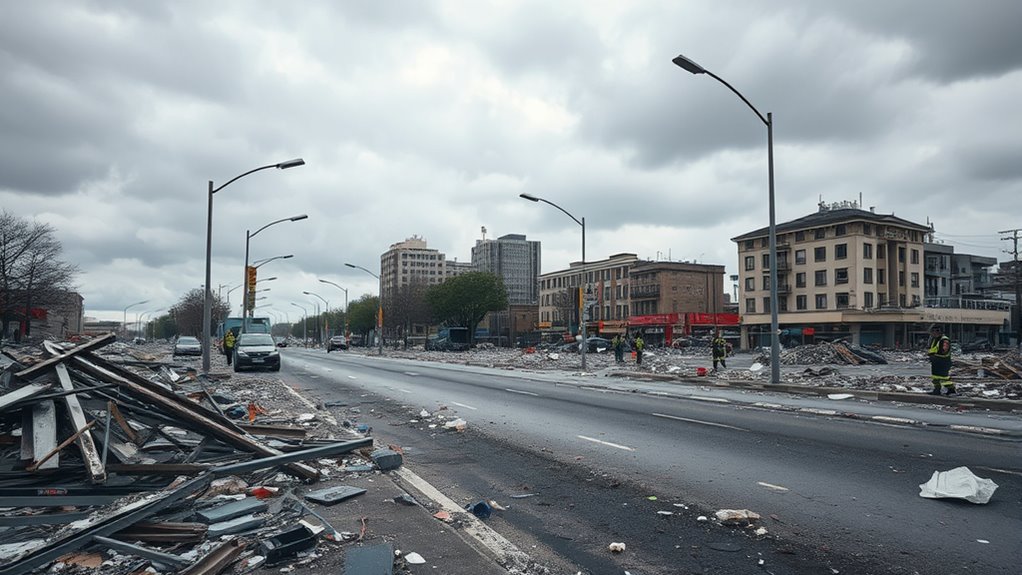
After a quake, your first step is to make certain you have emergency supplies ready to go. Building strong community support networks can help everyone recover more quickly, while paying attention to mental health keeps you resilient. Taking these safety measures boosts your ability to bounce back and rebuild effectively.
Emergency Supply Preparation
In the aftermath of a major quake, having an emergency supply kit ready can make all the difference in your safety and recovery. You need to prepare for immediate needs, focusing on essentials like food storage and water purification. Without these, you risk dehydration and hunger, worsening your situation. Guarantee your kit includes:
- Non-perishable food that lasts weeks and supports your nutritional needs.
- Water purification tablets or filters to keep drinking water safe.
- Emergency tools like flashlights, batteries, and a first aid kit to address injuries and maintain visibility.
These supplies will sustain you until help arrives or utilities are restored. Proper preparation minimizes panic and keeps you safe during critical moments after a quake strikes.
Community Support Networks
Community support networks play an essential role in post-disaster recovery and safety. They help keep neighborhood communication open, ensuring everyone stays informed and connected. By establishing clear lines of communication, you can quickly share critical information about safe routes, shelter locations, and available resources. Volunteer coordination is also crucial; organizing neighbors to assist with search and rescue, debris removal, or distributing supplies accelerates recovery efforts. These networks build resilience by fostering trust and cooperation, making communities more capable of handling the chaos after a mega-quake. Your active participation in neighborhood meetings or online groups can strengthen these connections. Remember, coordinated efforts and open communication are your best tools for safety and rebuilding in the aftermath of a disaster.
Mental Health Resilience
Maintaining mental health resilience is essential when recovering from a mega-quake, as the chaos can take a toll on everyone’s emotional well-being. To stay strong, focus on stress management techniques like mindfulness exercises that ground you in the present moment. Remember, your mental health is just as crucial as physical safety.
Here are ways to foster resilience:
- Practice mindfulness exercises daily to reduce anxiety and promote calmness.
- Create a routine that provides stability amid chaos, helping you regain control.
- Seek support from loved ones or mental health professionals to process your emotions.
Frequently Asked Questions
How Can I Stay Informed About New Earthquake Research and Safety Guidelines?
To stay informed about new earthquake research and safety updates, you should regularly follow reputable sources like seismic research institutions, government agencies, and emergency management websites. Subscribe to newsletters, join local safety programs, and participate in community drills. Staying connected with experts and monitoring official social media channels helps you get timely information, so you’re always prepared and aware of the latest safety guidelines and advancements in earthquake preparedness.
Are There Specialized Insurance Policies for Mega-Quake Damages?
You can find specialized insurance policies that include mega quake coverage, designed specifically for large-scale earthquake damages. These policies often go beyond standard earthquake insurance, offering broader protection for your property and belongings. Contact your insurer or look for providers that advertise specialized earthquake coverage. Make sure to review policy details carefully, so you’re aware of what’s covered in the event of a mega quake, giving you peace of mind and financial security.
What Are Effective Mental Health Strategies After Experiencing a Mega-Quake?
It’s no coincidence that after a mega-quake, focusing on emotional resilience helps you recover faster. You can strengthen your mental health by practicing mindfulness and staying connected with peer support groups. Sharing your feelings with others who understand your experience creates a sense of community and relief. Remember, acknowledging your emotions and seeking support are crucial steps to rebuilding your mental strength after such a devastating event.
How Can Businesses Prepare for Mega-Quake Disruptions?
To prepare for mega-quake disruptions, you should focus on strengthening your business continuity plan and enhancing supply chain resilience. Identify critical operations and develop backup strategies, like alternative suppliers and remote work capabilities. Regularly conduct drills to guarantee staff are prepared. By proactively addressing vulnerabilities, you can minimize downtime, protect assets, and keep your business running smoothly during and after a major earthquake.
What Technological Innovations Are Being Developed for Early Earthquake Detection?
You should know that seismic sensors and artificial intelligence are revolutionizing early earthquake detection. Seismic sensors continuously monitor ground movements, providing real-time data. Artificial intelligence analyzes this data quickly, identifying patterns that predict quakes before they happen. These innovations enable faster alerts, giving you vital seconds to take safety measures. Staying informed about these technologies helps you prepare better and respond promptly, reducing risks during an earthquake.
Conclusion
While it’s tempting to think you’ll always be safe, preparing for a mega-quake isn’t just about peace of mind—it’s about facing the irony that nature’s biggest surprises can catch us off guard. So, stay vigilant, plan ahead, and secure what you can. Because when the earth trembles, you’ll wish you’d prepared more than just your emergency kit. Better safe than sorry, right? After all, Mother Nature loves a good surprise.





